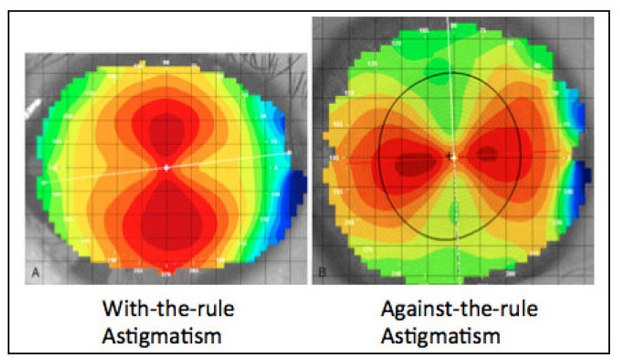 |
| Corneal astigmatism may persist throughout life, but clinicians should be more aware of a possible shift in axis over time from WTR to ATR. Photo: Marc Bloomenstein, OD. Click image to enlarge. |
To better understand and document changes in astigmatism with age, researchers recently evaluated shifts from with-the-rule (WTR) to against-the-rule (ATR) toricity over a span of 20 year. They found that such a change was more than three times more likely to pass through oblique cylinder axes as through a spherical prescription. Changes in ocular astigmatism occurred after the mid-40s (55%) with many (41%) showing no changes until after their mid-50s.
Longitudinal assessments were made of the changes in astigmatism for 326 patients (mean age at first prescription 46 years, range 28 to 69 years) and 640 eyes through their recorded prescription history (median 20 years of prescription data per participant, range 18 to 29 years).
For patients aged 28 to 40 years at their first eye exam, 55% of eyes had an onset of astigmatic changes at a mean of 44 years and 41% of eyes had no change until after a mean of 54 years. 36% of the eyes had an oblique cylinder prescribed at least once in their refraction history.
“Of these, 78% were found to be transient in nature and could consequently cause more patient complaints than if the oblique cylinder was more stable and the patient had adapted to it,” the authors noted in the study.
Of the eyes with a history of variable cylinders, 44 had an oblique cylinder prescribed at some point in their history, “suggesting that a clinician who is happy to change the axis of a cylinder by large degrees is also happy to prescribe an oblique cylinder, with an associated increase in the likelihood of a patient complaint with their new spectacles.”
The importance of reconciling changes in astigmatism with the patient’s previous prescription and the risks of making changes in oblique astigmatism need more emphasis in clinician training, the authors suggested. “Changes in the prescribed cylinder appear rare for patients younger than their mid-30s; 41% showed no change until after their mid-50s and most (55%) showed a change only after their mid-40s,” they explained. “Increases in ATR astigmatism tended to commence later in the mid-50s and changed at a greater rate per decade than the decreases in WTR found at younger ages (0.71D vs. 0.34D per decade).”
Beesley J, Elliott DB. Changes in ocular astigmatism with age: a longitudinal study. Ophthalmic Physiol Opt. September 7, 2023. [Epub ahead of print.] |

